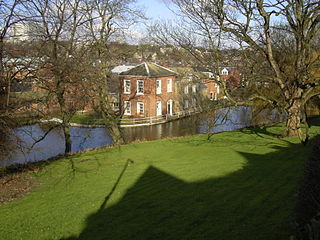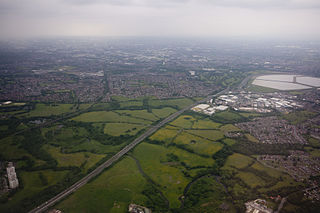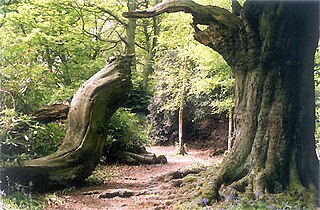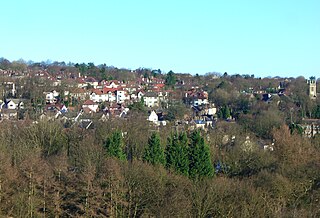This article needs additional citations for verification .(November 2017) |

The Shire Brook Valley Local Nature Reserve is located in Sheffield, England, on a former brownfield industrial site.
This article needs additional citations for verification .(November 2017) |

The Shire Brook Valley Local Nature Reserve is located in Sheffield, England, on a former brownfield industrial site.
The Local Nature Reserve was designated in 1999 [1] and extends over an area of approximately 100 hectares. [2] [3]

It is based around the former site of the Coisley Hill Sewage Works which closed in the early 1990s. The manager's office has been converted into a visitors' centre. The reserve includes Beighton Marsh, an area of reed-grass swamp situated at its eastern end, which supports birds such as Reed Bunting, Grasshopper Warbler and Barn Owl, as well as mammals such as the Harvest Mouse and Water Vole. The Birley Spa Bath House, a Grade II listed building, was restored with a Heritage Lottery Fund grant in 2001. [4] Also within the reserve is Wickfield Plantation, one of the few remaining areas of lowland heath and coppiced oak woodland inside Sheffield.
The reserve contains Carr Forge Dam which is fed by a stream from Birley Spa and is a location for wildlife. New ponds were created in the same area to mark the centenary of the City of Sheffield. The Centenary Ponds were opened by Clive Betts on 18 June 1993. Further ponds were created in 2016 to encourage amphibians. Also added to the eastern side of the reserve is a landscaped former landfill site, called Linley Bank Meadow, now home to skylarks and a likely location for soaring buzzards. [1]
The reserve is popular with cyclists and walkers, having a network of paths and the Transpennine Trail running through is used by a running club, for orienteering events, geocaching, company team-building days, school visits etc. [5] The reserve has a car-park accessed from Stone Lane.
Fishing is banned on the site as most access points involve walking under pylons which has resulted in fishing rods conducting electricity and burning anglers. After one bad accident in 2004, the council took the unusual step of removing all the fish from the site to deter anglers. [6] This decision was criticised by the Countryside Alliance. [7]
Carr Forge Dam is a dam located in the centre of the reserve. The dam dates back to the Tudor dynasty, and most of the brickwork still remains. The dam is now mainly used as a wildlife pond, with toads, frogs and other species including the endangered Great Crested Newt breeding in the marshes.
The Shirebrook Heritage Group was established in 1999 to maintain the Valley and its visitor's centre. They run a Park Ranger programme and hold regular meetings within the Birley Spa bath house and the visitor's centre itself.
Volunteers formed the group in 1989 and have been at the forefront in carrying out habitat conservation work on the nature reserve on a weekly/monthly basis, meeting on Wednesday and Saturday mornings.

The River Sheaf in Sheffield, South Yorkshire, England, flows northwards, past Dore, through Abbeydale and north of Heeley. It then passes into a culvert, through which it flows under the centre of Sheffield before joining the River Don. This lower section of the River Sheaf, together with the River Don between the Blonk Street and Lady's Bridges, formed two sides of the boundary of Sheffield Castle.

The Porter Brook is a river which flows through the City of Sheffield, England, descending over 1,000 feet (300 m) from its source on Burbage Moor to the west of the city to its mouth where it joins the River Sheaf in a culvert beneath Sheffield railway station. Like the other rivers in Sheffield, its steep gradient made it ideal for powering water mills and works associated with the metalworking and cutlery industries, and around 20 dams were constructed over the centuries to facilitate this. At its lower end, it is extensively culverted, but parts of it are gradually being restored to open channels, as part of a daylighting scheme for the city.

The Moss is a brook in North East Derbyshire, England.

Birley Spa is a grade-II listed community bath hall and a Victorian bathhouse in the Hackenthorpe district of the City of Sheffield, England.

The River Rivelin is a river in Sheffield, South Yorkshire, England.

Hackenthorpe is a village 5 miles south east of Sheffield’s city centre, now classed as a historic township of the city. Due to much expansion, the village became a part of Sheffield city during the 1950s. During much of the late 19th and 20th centuries the village was noted for its steelmaking, with the Thomas Staniforth & Co Sickle works being based at Main Street. Another prominent feature of the village is the 17th century Hackenthorpe Hall, built by John Newbould for the Hounsfield family, with James Hounsfield being a prominent land owner. The building is today used as a nursery.


Frecheville is a suburb five miles (8.0 km) south-east of Sheffield’s city centre. The estate was built in the 1930s when the area was in Derbyshire. However, due to expansion, Frecheville and a number of surrounding villages became part of the city of Sheffield in 1967 and thus the West Riding of Yorkshire.

Reddish Vale is in the Tame Valley close to Reddish, Greater Manchester, England. The centre of the vale is around the bottom of Reddish Vale Road. Reddish Vale Country Park is a country park managed by Stockport Metropolitan Borough Council. It covers 161 hectares in all and comprises some of the traditional Reddish Vale area, Reddish Vale Farm and the grazing land and Woodhall Fields, about 0.5 miles (0.80 km) to the south. Part of it is a designated local nature reserve.

The Blackburn Brook is a stream in Sheffield, South Yorkshire, England which flows through the Blackburn Valley along the M1 and Ecclesfield Road and joins the River Don near the Meadowhall shopping centre. Downstream from the A61 road at Chapeltown the Blackburn Brook is defined as a main river by the Environment Agency, which requires new building development to be at least 26 feet (8 m) from the bank side as a flood defence measure and to allow access to the watercourse for maintenance.

Ecclesall Woods is an area of woodland in south-west Sheffield, South Yorkshire, England, between Abbeydale Road South and Ecclesall. It covers approximately 350 acres (1.4 km2) of mature semi-natural deciduous woodland which was previously used for timber and charcoal, and is currently managed by the city council for the benefit of wildlife and visitor access. There are two roads and over 10 miles (16 km) of public footpaths running through the woods. The Abbeydale miniature railway is also located within the woods.


Shire Brook is a small stream in the south eastern part of the City of Sheffield in South Yorkshire, England. It rises in the suburb of Gleadless Townend and flows in a general easterly direction for 4 miles (6.5 km) to its confluence with the River Rother between Beighton and Woodhouse Mill. In the past the brook has been both the border of Yorkshire and Derbyshire and between the sees of Canterbury and York. The course of the stream has been influenced by human intervention in the 20th century with the brook being diverted underground and flowing through culverts on three occasions as it traverses locations which were formerly landfill sites and extensive railway sidings.

Sheffield & Rotherham Wildlife Trust is a charitable non-governmental organisation, covering Sheffield and Rotherham, South Yorkshire, England. It owns or manages 15 nature reserves with its base in Sheffield.

Donington and Albrighton is a local nature reserve being a valuable site for wildlife and recreation in Shropshire, it has a historical reference as it is the site of St Cuthberts Well which was believed to hold powers to cure the blind.

Fulwood is a residential suburb and ward of the City of Sheffield in England, it lies 5.5 km west-southwest of the city centre. Formerly an ancient settlement and village on the Porter Brook, it became integrated into the city in the 1930s. It is bounded by the suburbs of Lodge Moor to the NW, Ranmoor to the east and Crosspool to the NE. The open countryside of the Peak District lies to the west and SW. The sub districts of Stumperlowe and Goole Green are part of the suburb. The population of the ward at the 2011 Census was 18,233. Fulwood is located in the Sheffield Hallam constituency which, as of the 2019 general election voted Labour.
The Ochre Dyke is a small stream in the south eastern part of the City of Sheffield in South Yorkshire, England. It rises some 100m to the east/south east of the ruined barn known as Eckington Lees. This is at the extreme western end of Birley Wood Golf Course. Ochre Dyke flows east/south east along the southern border of the golf course and passes through Birley Wood; up to this point it is the county boundary between South Yorkshire and North East Derbyshire. During summer months the brook frequently dries up to this point. The Ochre dyke gets its name from the pollution of the water by yellow ochre as a result of coal mining activity in the upper reaches of the valley. The area in and around Birley wood was extensively mined for coal and black-band iron ore from at least the medieval period up to the mid 20th century when Dent Main Colliery closed. Other mines along the course of the stream were Moorhole Colliery East, Moorhole Colliery North and Moorhole Colliery South.

Normanton Spring, also called Normanton Springs, is a suburb and former hamlet located 4 miles east of Sheffield's City Centre, now classed as a historic township of the city. Due to expansion during the 1960s, the hamlet became a part of Sheffield City.

The Porter Valley Parks are a series of public parks and green spaces in Sheffield, England. Lying along the valley of Porter Brook, they run radially out from the city centre, providing a direct green-space connection to the Peak District national park. Created variously between 1855 and 1938, they comprise in order from the city centre; Endcliffe Park, Bingham Park, Whiteley Woods, Forge Dam Park and Porter Clough.
53°21′11″N1°22′12″W / 53.353°N 1.370°W